
Riddlesden is a suburb of Keighley in the county of West Yorkshire, England and on the Leeds and Liverpool Canal.

Shipley is a historic market town and civil parish in the City of Bradford, West Yorkshire, England, by the River Aire and the Leeds and Liverpool Canal, north of Bradford. The population of the Shipley ward on Bradford City Council taken at the 2011 Census was 15,483.

Baildon is a town and civil parish in the Bradford Metropolitan Borough in West Yorkshire, England and within the historic boundaries of the West Riding of Yorkshire.

Thornton is a village within the metropolitan borough of the City of Bradford, in West Yorkshire, England. It lies to the west of Bradford, and together with neighbouring Allerton, has total resident population of 15,004, increasing to 17,276 at the 2011 Census. Its most famous residents were the Brontës.
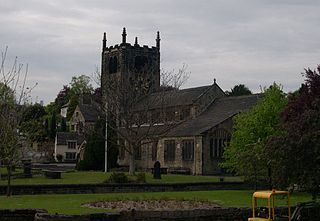
Church of All Saints is the Anglican parish church in the town of Bingley, West Yorkshire, England. It is one of two Anglican churches in the town, the other being Holy Trinity. All Saints has existed since Norman times and it is set in the oldest part of the town, near to where the River Aire is crossed by Ireland Bridge.

Bingley Three Rise Locks is a staircase of three locks on the Leeds and Liverpool Canal at Bingley, West Yorkshire, England. The locks are a Grade II* listed building.

Bradford Cathedral, or the Cathedral Church of St Peter, is an Anglican cathedral in Bradford, West Yorkshire, England, one of three co-equal cathedrals in the Diocese of Leeds alongside Ripon and Wakefield. Its site has been used for Christian worship since the 7th century, when missionaries based in Dewsbury evangelised the area. For many centuries it was the parish church of St Peter and achieved cathedral status in 1919. The cathedral is a Grade I listed building.

Giggleswick, a village and civil parish in the Craven district of North Yorkshire, England, lies on the B6480 road, less than 1 mile (1.6 km) north-west of the town of Settle and divided from it by the River Ribble. It is the site of Giggleswick School. The village belonged to the West Riding of Yorkshire until 1974.
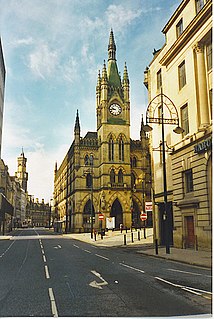
The Wool Exchange Building in Bradford, West Yorkshire, England is a grade I-listed building built as a wool-trading centre in the 19th century. The grandeur of its Gothic Revival architecture is symbolic of the wealth and importance that wool brought to Bradford. Today it is a Waterstones bookshop as well as a cafe.

The Alhambra Theatre is a theatre in Bradford, West Yorkshire, England, named after the Alhambra palace in Granada, Spain, which was the place of residence of the Emir of the Emirate of Granada. It was built in 1913 at a cost of £20,000 for theatre impresario Francis Laidler, and opened on Wednesday 18 March 1914. In 1964, Bradford City Council bought the Alhambra for £78,900 and in 1974, it was designated a Grade II listed building. It underwent extensive refurbishment in 1986. Today it is a receiving house for large-scale touring theatre of all types and the main house seats 1,456.
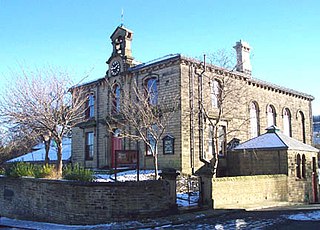
Cottingley is a suburban village within the City of Bradford in West Yorkshire, England between Shipley and Bingley. It is known for the Cottingley Fairies, which appeared in a series of photographs taken there during the early 20th century.

Little Germany is an area of particular historical and architectural interest in central Bradford, West Yorkshire, England. The architecture is predominantly neoclassical in style with an Italian influence. Many individual buildings are listed, and Little Germany is also protected as a Conservation Area.

Leeds Town Hall is a 19th-century municipal building on The Headrow, Leeds, West Yorkshire, England. Planned to include law courts, a council chamber, offices, a public hall, and a suite of ceremonial rooms, it was built between 1853 and 1858 to a design by the architect Cuthbert Brodrick. With the building of the Civic Hall in 1933, some of these functions were relocated, and after the construction of the Leeds Crown Court in 1993, the Town Hall now serves mainly as a concert, conference and wedding venue, its offices still used by some council departments. It was designated a Grade I listed building in 1951.

St Luke's Hospital is an NHS hospital in Bradford, West Yorkshire, England. It is situated on Little Horton Lane to the south-west of Bradford city centre. The hospital is managed by Bradford Teaching Hospitals NHS Foundation Trust. The main accommodation block is a grade II listed building.
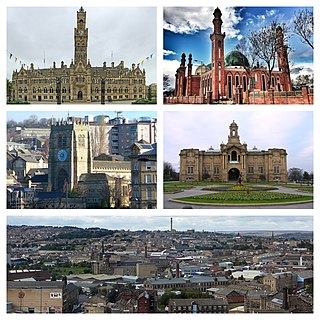
Bradford is a city in West Yorkshire, England. Bradford had a population of 349,561 at the 2011 census. It is the second-largest subdivision of the West Yorkshire Built-up Area after Leeds, which is approximately 8.6 miles (14 km) to the east. The City of Bradford district had a population of 539,776, making it the 7th most populous district in England.
Bradford Odeon is the name applied to two different cinemas in central Bradford, West Yorkshire, England. One, in Godwin Street, was built in 1930 and survives; the other, in Manchester Road, was built in 1938 and demolished in 1969.

The Milligan and Forbes Warehouse in Bradford, West Yorkshire, England is a grade II listed building built as the eponymous stuff merchants' warehouse in the 19th century. It is considered the city's first building in the Palazzo style and was very influential on 19th century Bradford architecture.
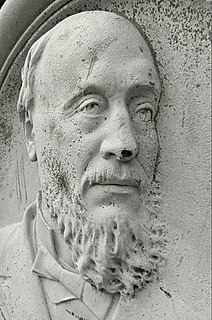
William Mawson was an English architect best known for his work in and around Bradford.

Robert Mawer was an architectural sculptor, based in Leeds, West Yorkshire, England. He specialised in the Gothic Revival and Neoclassical styles. He created the Neoclassical keystone heads on St George's Hall, Bradford and on Moorland's House, Leeds, and was working on the keystone heads at Leeds Town Hall when he died. He was a founding member of the Mawer Group of Leeds architectural sculptors, which included his wife, Catherine Mawer, his son Charles Mawer, and his apprentices William Ingle, Matthew Taylor and Benjamin Payler, who all became sculptors with their own careers. Many of the buildings enhanced with sculpture by Robert Mawer are now listed by Historic England.

Ilkley Town Hall, on Station Road, Ilkley, West Yorkshire, is a Grade II listed municipal building designed by William Bakewell of Leeds. It forms the centre of a small complex of public buildings, which also includes Ilkley Library, and the King's Hall & Winter Garden theatre. The library, Town Hall and King’s Hall opened in 1908 opposite Ilkley railway station; the Winter Garden was added to the west in 1914.




















